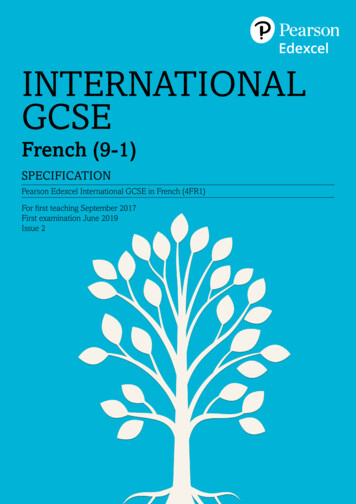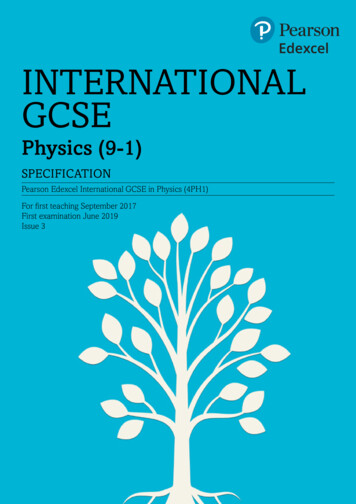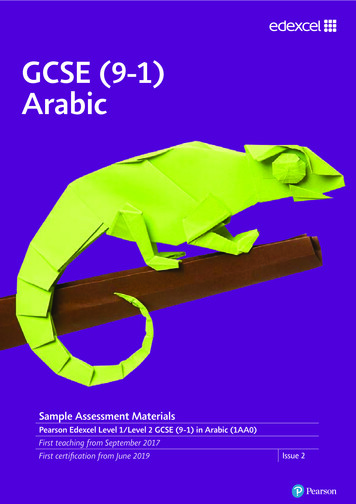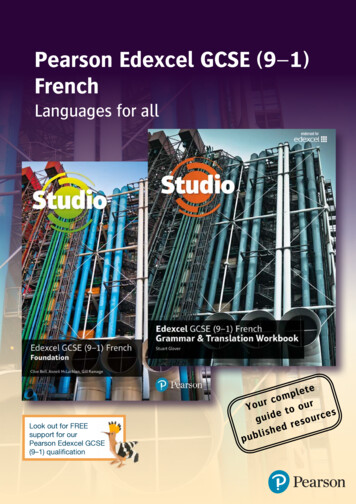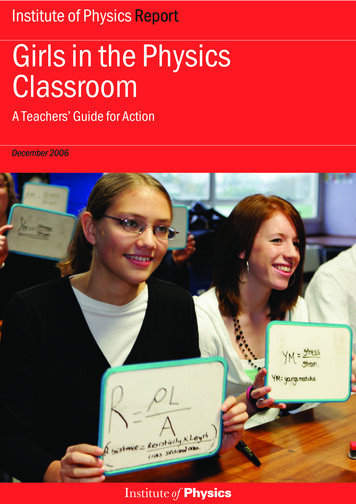
Transcription
GCSE (9-1)PhysicsSpecificationPearson Edexcel Level 1/Level 2 GCSE (9 - 1) in Physics (1PH0)First teaching from September 2016First certification from June 2018Issue 3
Summary of Pearson Edexcel Level 1/Level 2GCSE (9–1) in Physics (1PH0) specificationIssue 3 changesSummary of changes made between previous issue and this current issuePagenumberHead Teacher Declaration Form has been updated. The deadline to complete andsubmit the Head Teacher Declaration form has been changed from15th May to 15th April. Also, the form of submission has been changed from emailto a website upload.68If you need further information on these changes or what they mean, contact us via ourwebsite at: tml
Contents1Introduction2Why choose Edexcel GCSE in Physics?2Supporting you in planning and implementing this qualification3Qualification at a glance42Subject content63Assessment information464Administration and general information49Entries49Access arrangements, reasonable adjustments, special consideration andmalpractice49Student recruitment and progression52Appendix 1: Mathematical skills55Appendix 2: Equations in Physics57Appendix 3: SI Units in Physics61Appendix 4: Taxonomy62Appendix 5: Apparatus and techniques64Appendix 6: Practical Science Statement68Appendix 7: The context for the development of thisqualification69Appendix 8: Transferable skills71Appendix 9: Codes72Appendix 10: Calculators73
1 IntroductionWhy choose Edexcel GCSE in Physics?Supporting success in scienceScience matters. That’s why we’ve built the most inclusive GCSE (9–1) courses, so everystudent can enjoy science and succeed in their studies.Every student is different. With the same science and equal number of exams across ourtiered qualifications, you can structure the courses in the ways that mean you can bestsupport and stretch your students together.Our specifications are straightforward, and our selection of core practicals are designed tohelp bring science learning to life. And when it comes to our assessments, they’re shaped toencourage all students to best show what they know and can do.2Pearson Edexcel Level 1/Level 2 GCSE (9-1) in PhysicsSpecification – Issue 3 – February 2018 Pearson Education Limited 2018
Supporting you in planning and implementing thisqualificationPlanning Our Getting Started guide gives you an overview of the new GCSE qualifications to helpyou to get to grips with the changes to content and assessment and to help youunderstand what these changes mean for you and your students. We will give you editable schemes of work that you can adapt to suit your department. Our mapping documents highlight key differences between the new and 2011qualifications.Teaching and learningThere will be lots of free teaching and learning support to help you deliver the newqualifications, including: a free series of teacher, student and technician worksheets will help cover each elementof planning and delivering every core practical a free practical guide to help you prepare for the changes to practical assessment a free maths guide for scientists to help you embed mathematics in your scienceteaching.Preparing for examsWe will also provide a range of resources to help you prepare your students for theassessments, including: additional assessment materials to support formative assessments and mock exams marked exemplars of student work with examiner commentaries.ResultsPlusResutsPlus provides the most detailed analysis available of your students’ examperformance. It can help you identify the topics and skills where further learning wouldbenefit your students.Get help and supportOur subject advisor service, led by Stephen Nugus and Julius Edwards will ensure youreceive help and guidance from us and that you can share ideas and information with otherteachers.Learn more at qualifications.pearson.comexamWizardexamWizard is a free exam preparation tool containing a bank of Edexcel GCSE Scienceexam questions, mark schemes and examiners’ reports. Existing questions will be reviewedand tagged to our new specifications so they can still be used, and question descriptions willbe updated.Pearson Edexcel Level 1/Level 2 GCSE (9-1) in PhysicsSpecification – Issue 3 – February 2018 Pearson Education Limited 20183
Qualification at a glanceContent and assessment overviewThe Pearson Edexcel Level 1/Level 2 GCSE (9–1) in Physics consists of twoexternally-examined papers. These are available at foundation tier and higher tier.Students must complete all assessments in the same tier.Students must complete all assessment in May/June in any single year.Paper 1 (*Paper code: 1PH0/1F and 1PH0/1H)Written examination: 1 hour and 45 minutes50% of the qualification100 marksContent overview Topic 1 – Key concepts of physics Topic 2 – Motion and forces Topic 3 – Conservation of energy Topic 4 – Waves Topic 5 – Light and the electromagnetic spectrum Topic 6 – Radioactivity Topic 7 – AstronomyAssessment overviewA mixture of different question styles, including multiple-choice questions, short answerquestions, calculations and extended open-response questions.Calculators may be used in the examination. Information on the use of calculators duringthe examinations for this qualification can be found in Appendix 10: Calculators.*See Appendix 9: Codes for a description of this code and all other codes relevant to thisqualification.4Pearson Edexcel Level 1/Level 2 GCSE (9-1) in PhysicsSpecification – Issue 3 – February 2018 Pearson Education Limited 2018
Paper 2 (Paper code: 1PH0/2F and 1PH0/2H)Written examination: 1 hour and 45 minutes50% of the qualification100 marksContent overview Topic 1 – Key concepts of physics Topic 8 – Energy - Forces doing work Topic 9 – Forces and their effects Topic 10 – Electricity and circuits Topic 11 – Static electricity Topic 12 – Magnetism and the motor effect Topic 13 – Electromagnetic induction Topic 14 – Particle model Topic 15 – Forces and matterAssessment overviewA mixture of different question styles, including multiple-choice questions, short answerquestions, calculations and extended open-response questions.Calculators may be used in the examination. Information on the use of calculators duringthe examinations for this qualification can be found in Appendix 10: Calculators.Pearson Edexcel Level 1/Level 2 GCSE (9-1) in PhysicsSpecification – Issue 3 – February 2018 Pearson Education Limited 20185
2 Subject contentQualification aims and objectivesGCSE study in the sciences provides the foundation for understanding the material world.Scientific understanding is changing our lives and is vital to the world’s future prosperity. Allstudents should learn essential aspects of the knowledge, methods, processes and uses ofscience. They should gain appreciation of how the complex and diverse phenomena of thenatural world can be described in terms of a small number of key ideas that relate to thesciences and that are both inter-linked and of universal application. These key ideas include: the use of conceptual models and theories to make sense of the observed diversity ofnatural phenomena the assumption that every effect has one or more cause that change is driven by differences between different objects and systems when theyinteract that many such interactions occur over a distance without direct contact that science progresses through a cycle of hypothesis, practical experimentation,observation, theory development and review that quantitative analysis is a central element both of many theories and of scientificmethods of inquiry.These key ideas will be assessed through the content of this qualification in theexaminations.These key ideas are relevant in different ways and with different emphases in the threesubjects. Examples of their relevance are given for each subject in the separate sectionsbelow for Biology, Chemistry and Physics.The three GCSE Science qualifications enable students to: develop scientific knowledge and conceptual understanding through the specific disciplinesof Biology, Chemistry and Physics develop understanding of the nature, processes and methods of science, through differenttypes of scientific enquiries that help them to answer scientific questions about the worldaround them develop and learn to apply observational, practical, modelling, enquiry and problem-solving skills in the laboratory, in the field and in other learning environments develop their ability to evaluate claims based on science through critical analysis of themethodology, evidence and conclusions, both qualitatively and quantitatively.Students should study the sciences in ways that help them to develop curiosity about thenatural world, that give them an insight into how science works and that enable them toappreciate its relevance to their everyday lives. The scope and nature of the study should bebroad, coherent, practical and satisfying. It should encourage students to be inspired,motivated and challenged by the subject and its achievements.The key ideas specific to the Physics content include: the use of models, as in the particle model of matter or the wave models of light and ofsound the concept of cause and effect in explaining such links as those between force andacceleration, or between changes in atomic nuclei and radioactive emissions6Pearson Edexcel Level 1/Level 2 GCSE (9-1) in PhysicsSpecification – Issue 3 – February 2018 Pearson Education Limited 2018
the phenomena of ‘action at a distance’ and the related concept of the field as the key toanalysing electrical, magnetic and gravitational effects that differences, for example between pressures or temperatures or electrical potentials,are the drivers of change that proportionality, for example between weight and mass of an object or between forceand extension in a spring, is an important aspect of many models in science that physical laws and models are expressed in mathematical form.All of these key ideas will be assessed as part of this qualification, through the subjectcontent.Working scientificallyThe GCSE in Physics requires students to develop the skills, knowledge and understanding ofworking scientifically. Working scientifically will be assessed through examination and thecompletion of the eight core practicals.12Development of scientific thinkingaUnderstand how scientific methods and theories develop over time.bUse a variety of models, such as representational, spatial, descriptive,computational and mathematical, to solve problems, make predictions and todevelop scientific explanations and an understanding of familiar and unfamiliarfacts.cAppreciate the power and limitations of science, and consider any ethical issuesthat may arise.dExplain everyday and technological applications of science; evaluate associatedpersonal, social, economic and environmental implications; and make decisionsbased on the evaluation of evidence and arguments.eEvaluate risks both in practical science and the wider societal context, includingperception of risk in relation to data and consequences.fRecognise the importance of peer review of results and of communicating resultsto a range of audiences.Experimental skills and strategiesaUse scientific theories and explanations to develop hypotheses.bPlan experiments or devise procedures to make observations, produce orcharacterise a substance, test hypotheses, check data or explore phenomena.cApply a knowledge of a range of techniques, instruments, apparatus and materialsto select those appropriate to the experiment.dCarry out experiments appropriately, having due regard to the correctmanipulation of apparatus, the accuracy of measurements and health and safetyconsiderations.eRecognise when to apply a knowledge of sampling techniques to ensure anysamples collected are representative.fMake and record observations and measurements using a range of apparatus andmethods.gEvaluate methods and suggest possible improvements and further investigations.Pearson Edexcel Level 1/Level 2 GCSE (9-1) in PhysicsSpecification – Issue 3 – February 2018 Pearson Education Limited 20187
3Analysis and evaluationApply the cycle of collecting, presenting and analysing data, including:48apresenting observations and other data using appropriate methodsbtranslating data from one form to anotherccarrying out and representing mathematical and statistical analysisdrepresenting distributions of results and making estimations of uncertaintyeinterpreting observations and other data (presented in verbal, diagrammatic,graphical, symbolic or numerical form), including identifying patterns and trends,making inferences and drawing conclusionsfpresenting reasoned explanations, including relating data to hypothesesgbeing objective, evaluating data in terms of accuracy, precision, repeatability andreproducibility and identifying potential sources of random and systematic errorhcommunicating the scientific rationale for investigations, methods used, findingsand reasoned conclusions through paper-based and electronic reports andpresentations using verbal, diagrammatic, graphical, numerical and symbolicforms.Scientific vocabulary, quantities, units, symbols and nomenclatureaUse scientific vocabulary, terminology and definitions.bRecognise the importance of scientific quantities and understand how they aredetermined.cUse SI units (e.g. kg, g, mg; km, m, mm; kJ, J) and IUPAC chemical nomenclatureunless inappropriate.dUse prefixes and powers of ten for orders of magnitude (e.g. tera, giga, mega,kilo, centi, milli, micro and nano).eInterconvert units.fUse an appropriate number of significant figures in calculation.Pearson Edexcel Level 1/Level 2 GCSE (9-1) in PhysicsSpecification – Issue 3 – February 2018 Pearson Education Limited 2018
Practical workThe content includes eight mandatory core practicals, indicated as an entire specificationpoint in italics.Students must carry out all eight of the mandatory core practicals listed below.Core practical:2.19Investigate the relationship between force, mass and acceleration by varying themasses added to trolleys4.17Investigate the suitability of equipment to measure the speed, frequency andwavelength of a wave in a solid and a fluid5.9Investigate refraction in rectangular glass blocks in terms of the interaction ofelectromagnetic waves with matter5.19PInvestigate how the nature of a surface affects the amount of thermal energyradiated or absorbed.10.17Construct electrical circuits to:a investigate the relationship between potential difference, current and resistancefor a resistor and a filament lampb test series and parallel circuits using resistors and filament lamps14.3Investigate the densities of solid and liquids14.11Investigate the properties of water by determining the specific heat capacity ofwater and obtaining a temperature-time graph for melting ice15.6Investigate the extension and work done when applying forces to a springStudents will need to use their knowledge and understanding of these practical techniquesand procedures in the written assessments.Centres must confirm that each student has completed the eight mandatory core practicals.Students need to record the work that they have undertaken for the eight mandatory corepracticals. The practical record must include the knowledge, skills and understanding theyhave derived from the practical activities. Centres must complete and submit a PracticalScience Statement (see Appendix 6) to confirm that all students have completed the eightmandatory core practicals. This must be submitted to Pearson by 15th April in the year thatthe students will sit their examinations. Any failure by centres to provide this PracticalScience Statement will be treated as malpractice and/or maladministration.Scientific diagrams should be included, where appropriate, to show the set-up and to recordthe apparatus and procedures used in practical work.It is important to realise that these core practicals are the minimum number of practicalsthat should be taken during the course. Suggested additional practicals are given beneaththe content at the end of each topic. The eight mandatory core practicals cover all aspects ofthe apparatus and techniques listed in Appendix 5: Apparatus and techniques. This appendixalso includes more detailed instructions for each core practical, which must be followed.Pearson Edexcel Level 1/Level 2 GCSE (9-1) in PhysicsSpecification – Issue 3 – February 2018 Pearson Education Limited 20189
Safety is an overriding requirement for all practical work. Centres are responsible forensuring appropriate safety procedures are followed whenever their students completepractical work.These core practicals may be reviewed and amended if changes are required to theapparatus and techniques listed by the Department for Education. Pearson may also reviewand amend the core practicals if necessary. Centres will be told as soon as possible aboutany changes to core practicals.Qualification contentThe following notation is used in the tables that show the content for this qualification: text in bold indicates content that is for higher tier only entire specification points in italics indicates the core practicals.Specification statement numbers with a P in them refer to content which is only in the GCSEin Physics and is not found in the GCSE in Combined Science (e.g. 3.18P).MathematicsMaths skills that can be assessed in relation to a specification point are referenced in themaths column, next to this specification point. Please see Appendix 1: Mathematical skills forfull details of each maths skill.After each topic of content in this specification, there are details relating to the ‘Use ofmathematics’ which contains the Physics specific mathematic skills that are found in eachtopic of content in the document Biology, Chemistry and Physics GCSE subject content,published by the Department for Education (DfE) in June 2014. The reference in bracketsafter each statement refers to the mathematical skills from Appendix 1.EquationsThe required physics equations are listed in Appendix 2: Equations in Physics. The first listshows the equations which students are expected to recall for use in the exam papers. Theseequations may sometimes be given in the exam papers. The equations required for highertier only are shown in bold text. These equations are also listed in the specification content.10Pearson Edexcel Level 1/Level 2 GCSE (9-1) in PhysicsSpecification – Issue 3 – February 2018 Pearson Education Limited 2018
Topics common to Paper 1 and Paper 2Topic 1 – Key concepts of physicsStudents should:Maths skills1.1Recall and use the SI unit for physical quantities, as listed inAppendix 31.2Recall and use multiples and sub-multiples of units, includinggiga (G), mega (M), kilo (k), centi (c), milli (m), micro (μ) andnano (n)3c1.3Be able to convert between different units, including hours toseconds1c1.4Use significant figures and standard form where appropriate1bUse of mathematics Make calculations using ratios and proportional reasoning to convert units and to computerates (1c, 3c).Pearson Edexcel Level 1/Level 2 GCSE (9-1) in PhysicsSpecification – Issue 3 – February 2018 Pearson Education Limited 201811
Topics for Paper 1Topic 2 – Motion and forcesStudents should:Maths skills2.1Explain that a scalar quantity has magnitude (size) but nospecific direction2.2Explain that a vector quantity has both magnitude (size) and aspecific direction5b2.3Explain the difference between vector and scalar quantities5b2.4Recall vector and scalar quantities, including:a displacement/distanceb velocity/speedc accelerationd forcee weight/massfmomentumg energy2.5Recall that velocity is speed in a stated direction2.6Recall and use the equations:a (average) speed (metre per second, m/s) distance(metre, m) time (s)b distance travelled (metre, m) average speed (metre persecond, m/s) time (s)2.72.8Analyse distance/time graphs including determination of speedfrom the gradientRecall and use the equation:acceleration (metre per second squared, m/s2) change invelocity (metre per second, m/s) time taken (second, s)(v u )a 5b1a, 1c, 1d2a3a, 3c, 3d2a4a, 4b, 4d, 4e1a, 1c, 1d2a3a, 3b, 3c, 3dt2.91a, 1c, 1dUse the equation:(final velocity)2 ((metre/second)2, (m/s)2) – (initial velocity)2((metre/second)2, (m/s)2) 2 acceleration (metre persecond squared, m/s2) distance (metre, m)2a3a, 3c, 3dv2 u2 2 a x12Pearson Edexcel Level 1/Level 2 GCSE (9-1) in PhysicsSpecification – Issue 3 – February 2018 Pearson Education Limited 2018
Students should:2.10Analyse velocity/time graphs to:a compare acceleration from gradients qualitatively2.11Maths skills1a, 1c, 1d2ab calculate the acceleration from the gradient (for uniformacceleration only)4a, 4b, 4c, 4d,4e, 4fc determine the distance travelled using the area betweenthe graph line and the time axis (for uniform accelerationonly)5cDescribe a range of laboratory methods for determining thespeeds of objects such as the use of light gates1a, 1d2a, 2b, 2c, 2f,2h3a, 3c, 3d4a, 4c2.12Recall some typical speeds encountered in everydayexperience for wind and sound, and for walking, running,cycling and other transportation systems2.13Recall that the acceleration, g, in free fall is 10 m/s2 and beable to estimate the magnitudes of everyday accelerations2.141d2hRecall Newton’s first law and use it in the following situations:1a, 1da where the resultant force on a body is zero, i.e. the body ismoving at a constant velocity or is at rest2a3a, 3c, 3db where the resultant force is not zero, i.e. the speed and/ordirection of the body change(s)2.15Recall and use Newton’s second law as:force (newton, N) mass (kilogram, kg) acceleration(metre per second squared, m/s2)F m a2.16Define weight, recall and use the equation:weight (newton, N) mass (kilogram, kg) gravitational fieldstrength (newton per kilogram, N/kg)W m g2.17Describe how weight is measured2.18Describe the relationship between the weight of a body andthe gravitational field strength2.19Core Practical: Investigate the relationship between force,mass and acceleration by varying the masses added to trolleys1a, 1c, 1d2a3a, 3b, 3c, 3d1a, 1c, 1d2a3a, 3b, 3c, 3d1c1a, 1c,1d2a, 2b, 2f3a, 3b, 3c, 3d4a, 4b, 4c, 4dPearson Edexcel Level 1/Level 2 GCSE (9-1) in PhysicsSpecification – Issue 3 – February 2018 Pearson Education Limited 201813
Students should:Maths skills2.20Explain that an object moving in a circular orbit atconstant speed has a changing velocity (qualitativeonly)5b2.21Explain that for motion in a circle there must be aresultant force known as a centripetal force that actstowards the centre of the circle5b2.22Explain that inertial mass is a measure of how difficult itis to change the velocity of an object (including fromrest) and know that it is defined as the ratio of forceover acceleration1c,2.23Recall and apply Newton’s third law both to equilibriumsituations and to collision interactions and relate it to theconservation of momentum in collisions1a, 1c, 1d2.24Define momentum, recall and use the equation:momentum (kilogram metre per second, kg m/s) mass (kilogram, kg) velocity (metre per second, m/s)p m v2.25Describe examples of momentum in collisions2a3a, 3b, 3c, 3d1a, 1c, 1d2a3a, 3b, 3c, 3d1a, 1c, 1d2a3a, 3b, 3c, 3d2.26Use Newton’s second law as:force (newton, N) change in momentum (kilogrammetre per second, kg m/s) time (second, s)F (mv mu )t1a, 1c, 1d2a3a, 3b, 3c, 3d2.27Explain methods of measuring human reaction times andrecall typical results2.28Recall that the stopping distance of a vehicle is made up of thesum of the thinking distance and the braking distance1a2.29Explain that the stopping distance of a vehicle is affected by arange of factors including:1c, 1da the mass of the vehicle2a, 2b, 2c, 2g2b, 2c, 2h3b, 3cb the speed of the vehiclec the driver’s reaction timed the state of the vehicle’s brakese the state of the roadf14the amount of friction between the tyre and the roadsurfacePearson Edexcel Level 1/Level 2 GCSE (9-1) in PhysicsSpecification – Issue 3 – February 2018 Pearson Education Limited 2018
Students should:2.30Maths skillsDescribe the factors affecting a driver’s reaction time includingdrugs and distractions1d2b, 2h3c2.312.32PExplain the dangers caused by large decelerations andestimate the forces involved in typical situations on apublic roadEstimate how the distance required for a road vehicle to stopin an emergency varies over a range of typical speeds1c, 1d,2c, 2h,3b, 3c1a, 1c, 1d2a3a, 3b, 3c, 3d2.33PCarry out calculations on work done to show the dependenceof braking distance for a vehicle on initial velocity squared(work done to bring a vehicle to rest equals its initial kineticenergy)1c, 1d2b, 2h3b, 3cUse of mathematics Make calculations using ratios and proportional reasoning to convert units and to computerates (1c, 3c). Relate changes and differences in motion to appropriate distance-time, and velocity-timegraphs, and interpret lines and slopes (4a, 4b, 4c, 4d). Interpret enclosed areas in velocity-time graphs (4a, 4b, 4c, 4d, 4f). Apply formulae relating distance, time and speed, for uniform motion, and for motion withuniform acceleration, and calculate average speed for non-uniform motion (1a, 1c, 3c). Estimate how the distances required for road vehicles to stop in an emergency, variesover a range of typical speeds (1c, 1d, 2c, 2h, 3b, 3c). Apply formulae relating force, mass and relevant physical constants, includinggravitational field strength, to explore how changes in these are inter-related (1c, 3b, 3c). Apply formulae relating force, mass, velocity and acceleration to explain how the changesinvolved are inter-related (3b, 3c, 3d). Estimate, for everyday road transport, the speed, accelerations and forces involved inlarge accelerations (1d, 2b, 2h, 3c).Suggested practicals Investigate the acceleration,g, in free fall and the magnitudes of everyday accelerations. Investigate conservation of momentum during collisions. Investigate inelastic collisions with the two objects remaining together after the collisionand also ‘near’ elastic collisions. Investigate the relationship between mass and weight. Investigate how crumple zones can be used to reduce the forces in collisions.Pearson Edexcel Level 1/Level 2 GCSE (9-1) in PhysicsSpecification – Issue 3 – February 2018 Pearson Education Limited 201815
Topic 3 – Conservation of energyStudents should:3.1Maths skillsRecall and use the equation to calculate the change ingravitational PE when an object is raised above the ground:change in gravitational potential energy (joule, J) mass(kilogram, kg) gravitational field strength (newton perkilogram, N/kg) change in vertical height (metre, m)1a, 1c, 1d2a3a, 3b, 3c, 3d GPE m g h3.2Recall and use the equation to calculate the amounts ofenergy associated with a moving object:1 mass (kilogram, kg) kinetic energy (joule, J) 21a, 1c, 1d2a3a, 3b, 3c, 3d(speed)2 ((metre/second)2, (m/s)2)KE 12 m v 23.3Draw and interpret diagrams to represent energy transfers1c2c3.4Explain what is meant by conservation of energy3.5Analyse the changes involved in the way energy is storedwhen a system changes, including:a an object projected upwards or up a slopeb a moving object hitting an obstaclec an object being accelerated by a constant forced a vehicle slowing downe bringing water to a boil in an electric kettle3.6Explain that where there are energy transfers in a closedsystem there is no net change to the total energy in thatsystem3.7Explain that mechanical processes become wasteful when theycause a rise in temperature so dissipating energy in heatingthe surroundings3.8Explain, using examples, how in all system changes energy isdissipated so that it is stored in less useful ways3.9Explain ways of reducing unwanted energy transfer includingthrough lubrication, thermal insulation3.10Describe the effects of the thickness and thermal conductivityof the walls of a building on its rate of cooling qualitatively3.11Recall and use the equation:efficiency 16(useful energy transferred by the device)(total energy sup plied to the device)1a, 1c, 1d2a3a, 3b, 3c, 3dPearson Edexcel Level 1/Level 2 GCSE (9-1) in PhysicsSpecification – Issue 3 – February 2018 Pearson Education Limited 2018
Students should:Maths skills3.12Explain how efficiency can be increased3.13Describe the main energy sources available for use on Earth(including fossil fuels, nuclear fuel, bio-fuel, wind, hydroelectricity, the tides and the Sun), and compare the ways inwhich both renewable and non-renewable sources are used2c, 2g3.14Explain patterns and trends in the use of energy resources2c, 2gUses of mathematics Make calculations using ratios and proportional reasoning to convert units and to computerates (1c, 3c). Calculate relevant values of stored energy and energy transfers; convert betweennewton-metres and joules (1c, 3c). Make calculations of the energy changes associated with changes in a system, recalling orselecting the relevant equations for mechanical, electrical, and thermal processes; therebyexpress in quantitative form and on a common scale the overall redistribution of energy inthe system (1a, 1c, 3c).Suggested practicals Investigate conservation of energy.Pearson Edexcel Level 1/Level 2 GCSE (9-1) in PhysicsSpecification – Issue 3 – February 2018 Pearson Education Limited 201817
Topic 4 – WavesStudents should:Maths skills4.1Recall that waves transfer energy and information withouttransferring matter4.2Describe evidence that with water and sound waves it is thewave and not the water or air itself that travels4.3Define and use the terms frequency and wavelength as appliedto waves4.4Use the terms amplitude, period, wave velocity and wavefrontas applied to waves4.5Describe the difference between longitudinal and transversewaves by referring to sound
Appendix 2: Equations in Physics 57 Appendix 3: SI Units in Physics 61 Appendix 4: Taxonomy 62 Appendix 5: Apparatus and techniques 64 Appendix 6: Practical Science Statement 68 Appendix 7: The context for the development of this qualification 69 Appendix 8: Transferable skills 71 Appendix 9: Codes 72 Appendix 10: Calculators 73
